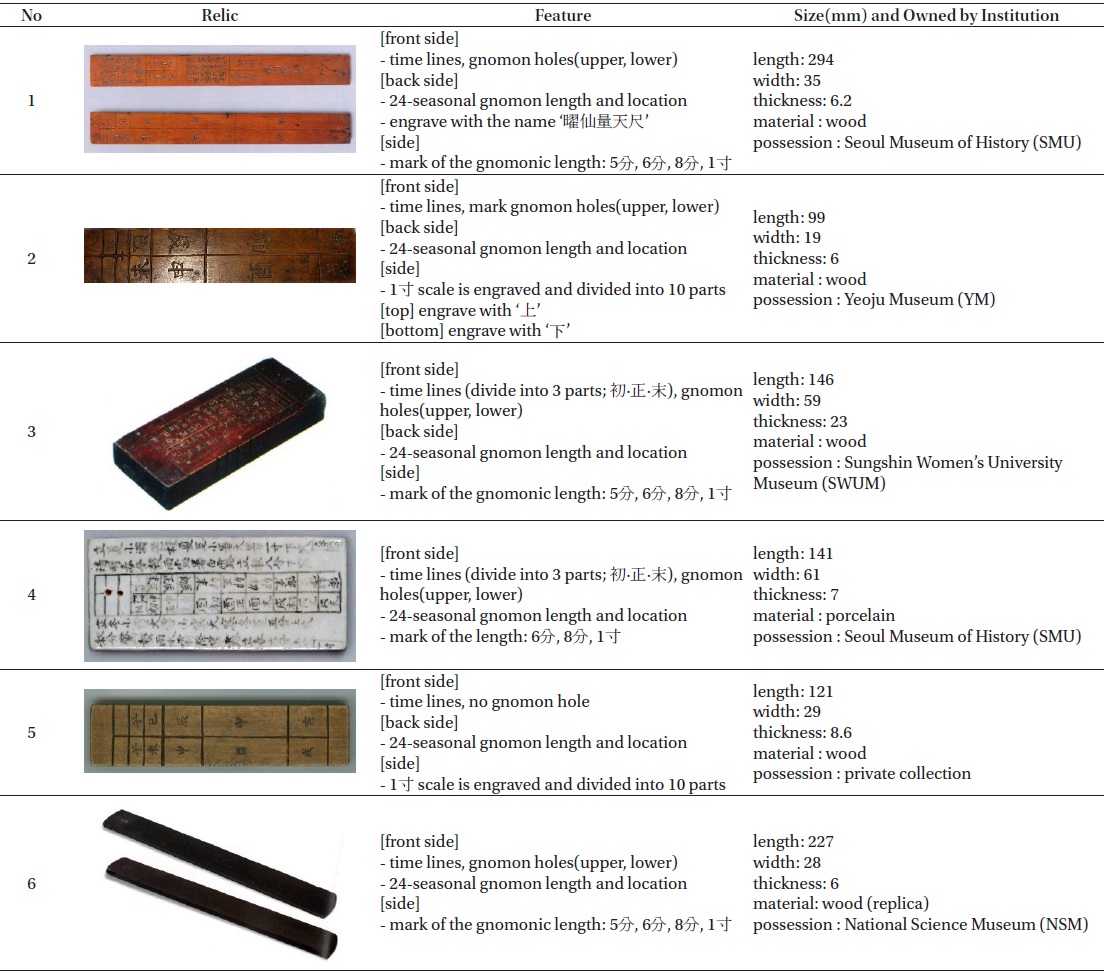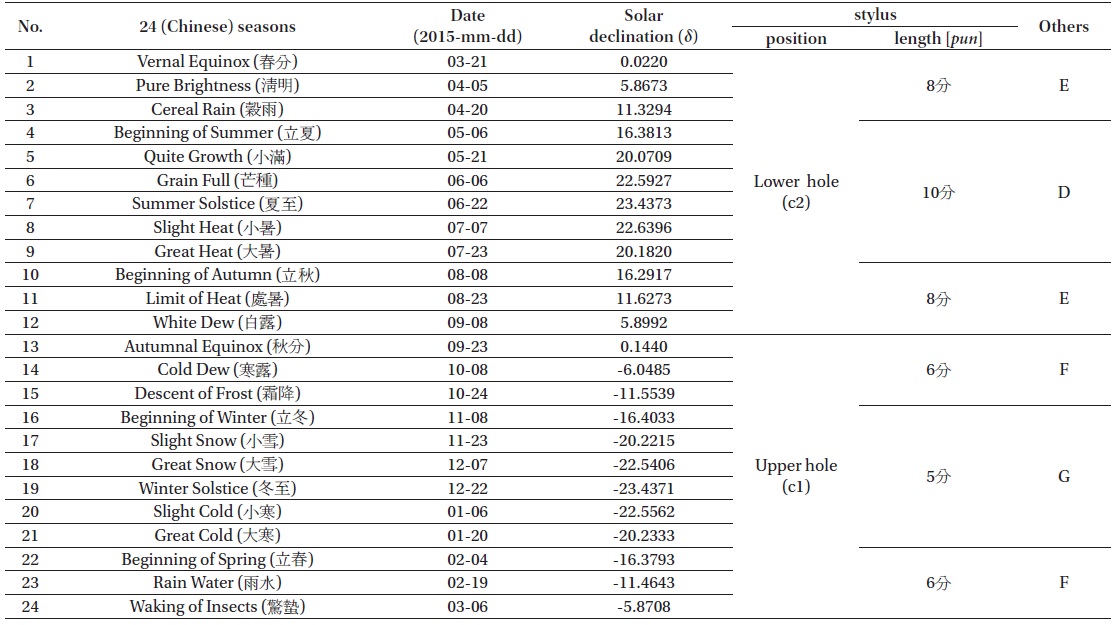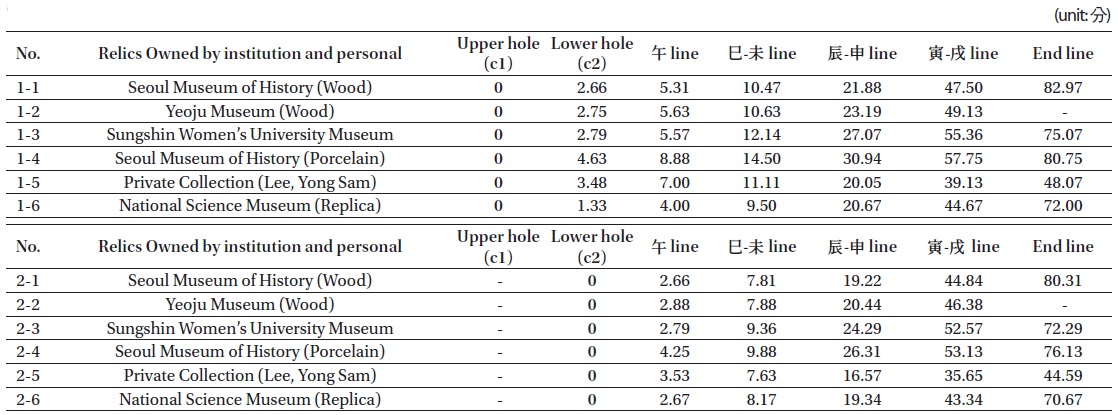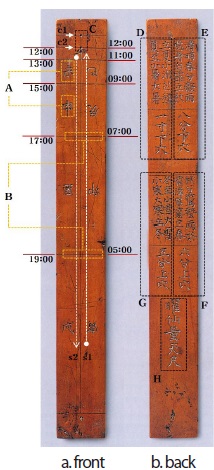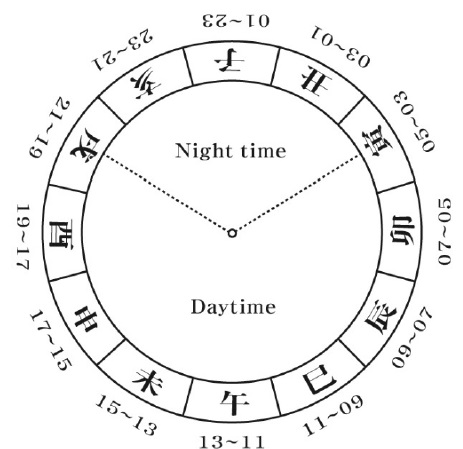During the reign of King Sejong in the early Joseon Dynasty, various sundials were developed such as the scaphe sundial, equatorial sundial, armillary sundial, and so forth (Nha et al. 1992; Jeon 2011). Because Western science was not introduced to the Joseon Dynasty until the 18th century, horizontal sundials and vertical sundials were either imported or manufacturing had just begun (Jeon et al. 1984; Kim et al. 2010; Kim et al. 2012; Lee et al. 2015). Among them, the Yang-cheon-cheok was one of the last wooden sundials of the Joseon Dynasty. This sundial was first discovered after conducting comprehensive research on the scientific cultural assets of Korea (Jeon et al. 1984). The discovery of the Yang-cheon-cheok was introduced at that time, but its historical background and scientific features were not analyzed. In this study, we investigated relics of the Yang-cheon-cheok as well as historical records. We also described the structure and usage of the Yang-cheon-cheok. Lastly, we estimated its historical value through an analysis of the specifications of several relics.
Yang-cheon-cheok literally means “ruler for measuring the heavens.” It was actually a type of sundial for measuring time. The account of Sukjong Sillok (the Veritable Record of King Sukjong) in 1712 (the 38th year of King Sukjong) said, “Yang-cheon-cheok is approximately 1 Ja (尺) or longer woodblock. It is covered by a thin tusk (象牙) on its back and is cut some notches in the unit of Chi (寸) and Pun (分); 12 lines in Chi and 10 lines in Pun in each line of Chi. On its surface, a Yun-do (輪圖, a compass) is planted and a small laminated gnomon is stood. It seems an instrument for measuring the length of a shadow (量天尺, 一木板長可一尺餘, 廣可數寸。 背布象牙, 刻以分寸, 寸爲十二畫, 分爲十畫, 上設輪圖, 中立一小板, 似是測景之具也。).”
As mentioned above, the length of a Yang-cheon-cheok was a bit over 1 Ja, but it is difficult to estimate the exact length of 1 Ja in the SI (International Standard) units of today. This is because there were several scales for length during the Joseon Dynasty. Though the Yang-cheon-cheok was primarily made of wood, some were luxurious and the backs were decorated with animal tusk. The marks using the units Chi and Pun were carved in 12 lines and 10 lines, respectively. We illustrate how the marks were drawn in Fig. 1 below.
In Fig. 1, 12 lines were needed for every 11 Chi, and 10 lines in Pun were needed between every two lines of Chi. In the account of Sukjong Sillok, the general length system for the Yang-cheon-cheok was described as 1 Chi = 10 Pun and 1 Ja = 10 Chi (1尺=10寸, 1寸=10分). In other words, the first stroke in Chi or Pun becomes the starting line for each unit, and the second stroke is one Chi or one Pun, respectively. The tenth line of Pun should not overlap with the second stroke of Chi, because the second stroke of Chi should not only offset but should also be the first stroke in Pun for the next set. That is, all Chi lines form the first line in Pun.
As analyzed above, the Yang-cheon-cheok in the account of Sukjong Sillok was 11 Chi (1.1 Ja). Therefore, it correlates with the expression of “approximately 1 Ja (尺) or longer.” Meanwhile, it is not certain why a Yun-do was needed to be installed, but it can be supposed that the solar position was measured through the compass. The length of the shadow of the small laminated gnomon (小板) casted by sunlight, not the length of stylus shadow, was measured.
There are six extant Yang-cheon-cheoks that were owned or introduced in literature or museums. Table 1 shows the features of and materials used in several Yang-cheon-cheoks that remain in the country. Relics of Yang-cheon-cheoks are usually made from wood or porcelain. They are approximately 120 mm to 300 mm long and are approximately 19 mm to 61 mm wide, and they are portable.
These relics are different from those referenced in Sukjong Sillok, because they do not possess a Yun-do or a laminated gnomon. However, one of relics in the Seoul Museum of History, marked as a “Yo-seon-yang-cheon-cheok” (曜仙量天尺), is made from wood. It is considered a type of Yang-cheon-cheok. It can also be understood that other relics in Table 1 are different types of Yang-cheon-cheok through their similarities to the Yo-seon-yang-cheon-cheok. Like a Yo-seon-yang-cheon-cheok, they have meaningful lines and similar instructions.
In terms of measurement, a Yang-cheon-cheok is similar to an altitude sundial that faces the sun to determine the length of the shadow of its stylus. However, different from an altitude sundial (Lee et al. 2015), a Yang-cheon-cheok has hour-lines and no seasonal lines. The external structure of the Yang-cheon-cheok resembles that of a typical Gyupyo (圭表, gnomon), because scales for hour-lines are drawn on the Yang-cheon-cheok like a dial for a gnomon, and there is a hole on its surface where a stick can be placed, much like the like stylus for a gnomon.
Among the other relics, the Yo-seon-yang-cheon-cheok is shown in Fig. 2. “Yo-seon” (曜仙) literally means “shiny Taoist monk.” There are two holes (C) above the hour-lines (B) on the front of the Yo-seon-Yang-cheon-cheok. There is an upper hole (c1) and a lower hole (c2). On the back, there is an instruction table (D, E, F, and G) for 24 seasons and the name of the relic in Chinese characters (H).
Table 2 interprets the instructions for the Yang-cheon-cheok, and the season stylus is explained in terms of the size and placement. Four types of styluses, which are 5 Pun, 6 Pun, 8 Pun, and 10 Pun (1 Chi), were used in Yang-cheon-cheoks. A relatively short stylus was used in the winter season, because the altitude of the sun is lower when it passes the meridian. On the other hand, a long stylus was used in the summer season, because the altitude of the sun is relatively high. The upper hole is used for short styluses from two equinoxes to the winter solstice, whereas the lower hole is used for longer styluses in the summer.
Extant relics in Korea are different from each other in size. The Yo-seon-yang-cheon-cheok owned by the Seoul Museum of History is well-preserved (see Fig. 2), so it is an appropriate relic on which to investigate the structure and inscriptions of a Yang-cheon-cheok in detail. This wooden relic is 295 mm long, 35 mm wide, and 6.2 mm thick. On the lateral side, four marks for a stylus are carved. The lengths of 5 Pun, 6 Pun, 8 Pun, and 10 Pun (1 Chi) are 15.9 mm, 18-18.1 mm, 24.5 mm, and 31.9-32 mm, respectively. All the relics are different regarding the lengths of the four marks. Therefore, to compare one relic to another, the longest mark on each denotes the unit length of 1 Chi.
On the front of the Yo-seon-yang-cheon-cheok, there are hour-lines (see Part B in Fig. 2) of 12 Sijin (時辰, a doublehour) printed in Chinese characters (see Part A in Fig. 2) between the lines corresponding to the time interval of the hour. Fig. 3 is a diagram for the 12 double-hours in a day. In Fig. 3, the outside of the 12 double-hour bands is contrasted with the modern 24 hours. Styluses from this sundial were shadowed on the front from the Myo (卯) hour to the Yu (酉) hour in most of the relics, not from the In (寅) hour to the Sul (戌) hour as in the case of the Yo-seon-yang-cheon-cheok.
3.2 Measurements
Due to the same structure of the gnomon, the shadow of the stylus was measured on the Yang-cheon-cheok to be appropriate for the 24 seasons. While 24 seasons in the instant of the meridian pass of the sun were measured by gnomon in ole East Asia, the time was measured by the Yang-cheon-cheok because only hour-lines were carved, regardless of the season. Therefore, the Yang-cheon-cheok has different measurements from the gnomon.
To measure the time of a day using the Yang-cheon-cheok, it should be set to face the sun every time. That is similar to the measurements of an altitude sundial. Unlike the Yang-cheon- cheok, the hour-lines of an altitude sundial have a curve that reflects the change of the shadow length for each season. Using the same double-hour-lines year around, the Yang-cheon-cheok should be relatively accurate regardless of the length of stylus according to the season (Fig. 4).
The solar altitude during the day has symmetry with respect to time when the sun passes the meridian line. Therefore, the shadow, cast by the sun, has the same length at two different times during the day, before and after the meridian passing time, when the shadow is the shortest. In Fig. 2(a) and Fig. 3, the Sa (巳) and Mi (未) hour, the Jin (辰) and Sin (申) hour, the Myo (卯) and Yu (酉) hour, and the In (寅) and Sul (戌) hour share the same space on the dial. If the solar altitude is too low, the shadow of the stylus goes off the last hour line of the Yang-cheon-cheok.
It is difficult to measure the exact time with a Yang-cheon-cheok, because only four styluses are used for one year. However, it is easy to manufacture and simple to measure time. It seems that this aspect led communities or certain classes to distribute a model of the Yang-cheon-cheok that had similar specifications – intervals for the hour-lines and the stylus’ length and position. Even though the Yang-cheon-cheok was an incomplete sundial, it seems it was used by many people engaged in commercial, medical, and financial activities, because it was portable.
As mentioned at Table 1, all of the relics have different lengths for the stylus and intervals of hour-lines (HL). We measured the length from the upper hole (c1) to the lower hole (c2) and to the hour-lines, and we compared each relic in Table 3. Here, HL1, HL2, HL3, HL4, and HL5 represent O (午) hour line, Sa (巳) and Mi (未) hour line, Jin (辰) and Sin (申) hour line, Myo (卯) and Yu (酉) hour line, In (寅) and Sul (戌) hour line, respectively. In the case of relics No. 5 and No. 6, the last line (HL5) is not an hour-line, but is a boundary line on the Yang-cheon-cheok. We also normalized the longest length of stylus to the unit length of 1 Chi.
Though relic No. 3 is similar to No. 6 in the hour-line intervals, the stylus’ unit length for relic No. 6 is approximately two times longer than that of relic No. 3. Relics No. 4 and No. 5 have similar hour-lines at the beginning, but both relics are different after HL3, and the unit length of the stylus is not equal. While the unit lengths of relics No. 1 and No. 6, 32 mm and 30 mm long, respectively, are similar, the distance between the two holes on relic No. 1 is more than double that of relic No. 6. These relics show various values regarding the unit length of the stylus and the distance between the hour-lines and c1. Even though four styluses were divided, it was not sufficient to measure the exact time with a fixed hour-line all year round because the solar altitude changes every hour each day during a year.
The unit lengths of styluses that are 1 Chi vary from 14 mm to 32 mm. In Table 4, the actual lengths of the styluses were carved on the lateral side and presented corresponding to 1 Chi, 8 Pun, 6 Pun, and 5 Pun for each relic. The length in SI units for 1 Chi is replaced by 10 (because 1 Chi = 10 Pun), but the other lengths for each relic are converted into values less than 10 and are shown in parenthesis. According to this table, there was a difference between actual size and the gnomonic mark. Relic No. 4, in porcelain, had a difference of approximately 1 pun (16 mm) between the actual size and the gnomonic mark. The differences may be due to errors in manufacturing.
The values in Table 5 are based on the values from Table 3 and are converted into values measured in Pun. Therefore, all lengths of hour-lines in each relic were standardized by the same unit of length and could be easily compared among the six relics. In Table 5, Nos. 1-1 through 1-6 show the distance from c1 to each hour-line during the winter, and Nos. 2-1 through 2-6 show the distance from c2 to each hour-line during the summer.
At the position of the stylus during the winter season (c1) in Table 5, Nos. 1-1, 1-2, and 1-3 have similar distances for the hour-lines. However, with the position of the stylus during the summer season (c2), Nos. 2-1, 2-2, and 2-6 also have similar distances for the hour-lines, and Nos. 2-3 and 2-4 have similarities as well. To verify the data in numerical form, we represented the average value and standard deviation of the hour-lines of these relics in Table 6 and Table 7.
In Tables 6 and 7, the further the hour-line from the standard, the greater the differences in the relics. As the standard deviation in Tables 6 and 7 is approximately 1 Pun, we can consider the hour-lines for each relic as corresponding. As c1 (upper hole) and c2 (lower hole) are considered the origins, respectively, No. 1 and No. 2 are made with similar, standard hour-lines. However, if only c2 is used as the origin, the hour-lines of No. 3 and one line from No. 4, one line from No. 1 (No. 2) and one line from No. 6 are made using a similar standard. Table 6 and Table 7 illustrate the estimated results as follows. First, two relics, No. 1 and No. 2, used the same clock for both winter and summer seasons, because the lengths of the styluses and the intervals for hour-lines were similar. Second, relics No. 3 and No. 4 used the same clock in the summer season. Even though the actual sizes of the relics were different, No. 1 and No. 2 of the Yang-cheon-cheok showed “similarities in the hour-lines.” Similarity in the hour-lines means the possibility that the Yang-cheon-cheok was made and distributed in various sizes.
We investigated six relics of the Yang-cheon-cheok, well-known in Korea. Among them, five were made from wood, and one was made with porcelain. Because of their size, the length of the Yang-cheon-cheok was under 30 cm, they could be easily made from a wooden plate with a convenient width and thickness. This Yang-cheon-cheok was storable, and the portable sizes of these relics were different. However, the marks for each hour-line and the inscriptions on the Yang-cheon-cheoks were similar. The lengths representing 1 Chi for the stylus in each relic were different. There were cases where the lengths of the styluses regarding to detail sizes (5 Pun, 6 Pun, and 8 Pun) did not correspond to the actual proportions. This showed that there were various types of Yang-cheon-cheoks, and they were not made precisely.
The Yang-cheon-cheok used four different styluses according to the season. Dividing the winter season and summer season, the styluses were used from different starting points. Regarding the six relics, the distances from the starting points of the styluses to the hour-lines were analyzed. Among these, the relic from the Seoul Museum of History (No. 1) and that of the Yeoju Museum (No. 2) had different sizes but measured similarly, because their styluses and hour-line lengths were proportional. In other relics, aspects of the standard deviation of each hour-line in the winter season and summer season were different. The porcelain Yang-cheon-cheok from the Sungshin Women’s University Museum (No. 3) and the wooden version from the Seoul Museum of History (No. 4) showed similar results in the summer season but no similarity in the winter season.
In the case of similar hour-lines in the Yang-cheon-cheoks, the standard deviation increased as time passed after the noon hour. Therefore, the Yang-cheon-cheok was not suitable for use in the early morning or the late afternoon. On the structural side, it would be difficult to use a Yang-cheon-cheok to measure time with accuracy. However, it was easy to make and was portable. Therefore, it was likely used as a popular sundial during the late Joseon Dynasty. There is evidence that this sundial was made in various sizes proportionally, expanding and reducing the stylus lengths and intervals of hour-lines. Regarding utilization, it would have been useful many people to be able to use the same time system.




